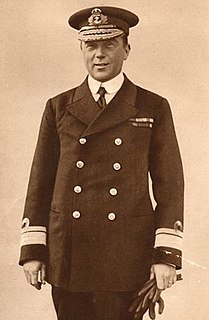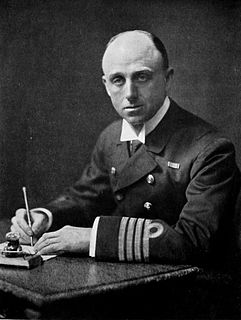
The Battle of Jutland was a naval battle fought between Britain's Royal Navy Grand Fleet, under Admiral Sir John Jellicoe, and the Imperial German Navy's High Seas Fleet, under Vice-Admiral Reinhard Scheer, during the First World War. The battle unfolded in extensive manoeuvring and three main engagements, from 31 May to 1 June 1916, off the North Sea coast of Denmark's Jutland Peninsula. It was the largest naval battle and the only full-scale clash of battleships in that war. Jutland was the third fleet action between steel battleships, following the Battle of the Yellow Sea in 1904 and the Battle of Tsushima in 1905, during the Russo-Japanese War. Jutland was the last major battle in history fought primarily by battleships.

HMS Inflexible was one of three Invincible-class battlecruisers built for the Royal Navy before World War I and had an active career during the war. She tried to hunt down the German battlecruiser SMS Goeben and the light cruiser SMS Breslau in the Mediterranean Sea when war broke out and she and her sister ship Invincible sank the German armoured cruisers SMS Scharnhorst and SMS Gneisenau during the Battle of the Falkland Islands. Inflexible bombarded Turkish forts in the Dardanelles in 1915, but was damaged by return fire and struck a mine while maneuvering. She had to be beached to prevent her from sinking, but she was patched up and sent to Malta, and then Gibraltar for more permanent repairs. Transferred to the Grand Fleet afterwards, she damaged the German battlecruiser Lützow during the Battle of Jutland in 1916 and watched Invincible explode. She was deemed obsolete after the war and was sold for scrap in 1921.

HMS Indomitable was one of three Invincible-class battlecruisers built for the Royal Navy before World War I and had an active career during the war. She tried to hunt down the German ships Goeben and Breslau in the Mediterranean when war broke out and bombarded Turkish fortifications protecting the Dardanelles even before the British declared war on Turkey. She helped to sink the German armoured cruiser Blücher during the Battle of Dogger Bank in 1915 and towed the damaged British battlecruiser HMS Lion to safety after the battle. She damaged the German battlecruisers Seydlitz and Derfflinger during the Battle of Jutland in mid-1916 and watched her sister ship HMS Invincible explode. Deemed obsolete after the war, she was sold for scrap in 1921.

Rear Admiral Sir Horace Lambert Alexander Hood, was a Royal Navy admiral of the First World War, whose lengthy and distinguished service saw him engaged in operations around the world, frequently participating in land campaigns as part of a shore brigade. His early death at the Battle of Jutland in the destruction of his flagship HMS Invincible was met with mourning and accolades from across Britain.

HMS Invincible was the lead ship of her class of three battlecruisers built for the Royal Navy during the first decade of the twentieth century and the first battlecruiser to be built by any country in the world. During the First World War, she participated in the Battle of Heligoland Bight in a minor role, as she was the oldest and slowest of the British battlecruisers present. During the Battle of the Falkland Islands, Invincible and her sister ship Inflexible sank the armoured cruisers Scharnhorst and Gneisenau almost without loss to themselves, despite numerous hits by the German ships.

The three Invincible-class battlecruisers were built for the Royal Navy and entered service in 1908 as the world's first battlecruisers. They were the brainchild of Admiral Sir John ("Jacky") Fisher, the man who had sponsored the construction of the world's first "all-big-gun" warship, HMS Dreadnought. He visualised a new breed of warship, somewhere between the armoured cruiser and battleship; it would have the armament of the latter, but the high speed of the former. This combination would allow it to chase down most ships, while allowing it to run from more powerful designs.
The 5th Battle Squadron was a squadron of the British Royal Navy consisting of battleships. The 5th Battle Squadron was initially part of the Royal Navy's Second Fleet. During the First World War, the Home Fleet was renamed the Grand Fleet.

The Indefatigable class were the second class built of British battlecruisers which served in the Royal Navy and the Royal Australian Navy during World War I. The design represented a modest reworking of the preceding Invincible class, featuring increased endurance and an improved cross-deck arc of fire for their midships wing turrets achieved by a lengthening of the hull. Like its predecessor, the design resembled the contemporary dreadnought of the Royal Navy, but sacrificed armour protection and one turret from the main battery for a 4-knot speed advantage.

Rear-Admiral Sir Robert Keith Arbuthnot, 4th Baronet, was a British Royal Navy officer during World War I. He was killed at the Battle of Jutland, when the cruiser squadron he commanded came under heavy fire after a bold but ill-judged attack on the German battle fleet.

The 1st Battle Squadron was a naval squadron of the British Royal Navy consisting of battleships. The 1st Battle Squadron was initially part of the Royal Navy's Grand Fleet. After World War I the Grand Fleet was reverted to its original name, the Atlantic Fleet. The squadron changed composition often as ships were damaged, retired or transferred.
The 6th Battle Squadron was a squadron of the British Royal Navy consisting of Battleships serving in the Grand Fleet and existed from 1913 to 1917.
The 2nd Battle Squadron was a naval squadron of the British Royal Navy consisting of battleships. The 2nd Battle Squadron was initially part of the Royal Navy's Grand Fleet. After World War I the Grand Fleet was reverted to its original name, the Atlantic Fleet. The squadron changed composition often as ships were damaged, retired or transferred.

The 3rd Battle Squadron was a naval squadron of the British Royal Navy consisting of battleships and other vessels, active from at least 1914 to 1945. The 3rd Battle Squadron was initially part of the Royal Navy's Home Fleet. During the First World War, the Home Fleet was renamed the Grand Fleet. During the Second World War, the squadron covered Atlantic convoys.

The 4th Battle Squadron was a squadron of the British Royal Navy consisting of battleships. The 4th Battle Squadron was initially part of the Royal Navy's Home Fleet (1912–14) and then the Grand Fleet after the outbreak of the First World War. The squadron changed composition often as ships were damaged, retired or transferred.

The First Battlecruiser Squadron was a Royal Navy squadron of battlecruisers that saw service as part of the Grand Fleet during the First World War. It was created in 1909 as the First Cruiser Squadron and was renamed in 1913 to First Battle Cruiser Squadron. It participated in the battles of Heligoland Bight, Dogger Bank and the Battle of Jutland. After the end of the war it became the sole Battlecruiser Squadron.

The 2nd Battlecruiser Squadron was a Royal Navy squadron of battlecruisers that saw service as part of the Grand Fleet during the First World War.
HMS Ophelia was an Admiralty M-class destroyer built for the Royal Navy during the First World War, entering service in 1916. The ship served at the Battle of Jutland on 31 May/1 June 1916, and sank a German submarine in 1918. She was sold for scrap in 1921.

Vice-Admiral Sir Edward Henry Fitzhardinge Heaton-Ellis, KBE, CB, MVO was a British Royal Navy officer.

The First Cruiser Squadron was a Royal Navy squadron of cruisers that saw service as part of the Grand Fleet during the World War I then later as part of the Mediterranean during the Interwar period and World War II it first established in 1904 and existed until 1952.













